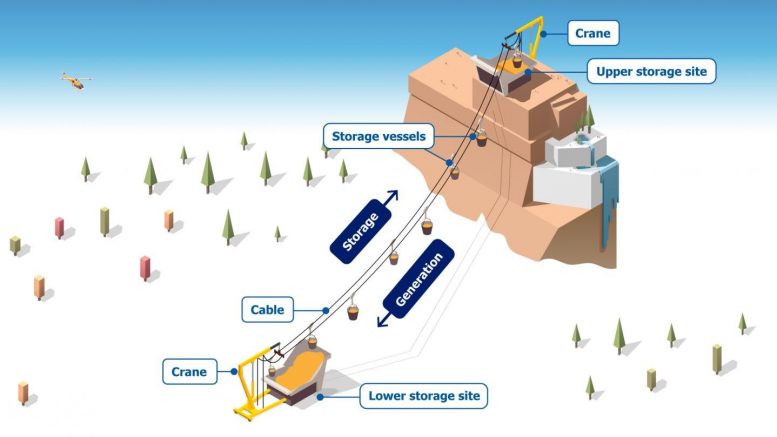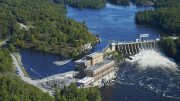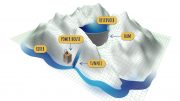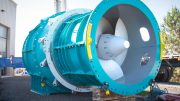
The storage of energy for long periods of time is subject to special challenges. An IIASA researcher proposes using a combination of Mountain Gravity Energy Storage (MGES) and hydropower as a solution for this issue. Credit: IIASA
The storage of energy for long periods of time is subject to special challenges. An IIASA researcher proposes using a combination of Mountain Gravity Energy Storage (MGES) and hydropower as a solution for this issue.
Batteries are rapidly becoming less expensive and might soon offer a cheap short-term solution to store energy for daily energy needs. However, the long-term storage capabilities of batteries, for example, in a yearly cycle, will not be economically viable. Although pumped-hydro storage (PHS) technologies are an economically feasible choice for long-term energy storage with large capacities – higher than 50 megawatts (MW) – it becomes expensive for locations where the demand for energy storage is often smaller than 20 MW with monthly or seasonal requirements, such as small islands and remote locations.
In a study published in the journal Energy on November 6, 2019, IIASA researcher Julian Hunt and his colleagues propose MGES to close the gap between existing short- and long-term storage technologies. MGES constitutes of building cranes on the edge of a steep mountain with enough reach to transport sand (or gravel) from a storage site located at the bottom to a storage site at the top. A motor/generator moves storage vessels filled with sand from the bottom to the top, similar to a ski lift. During this process, potential energy is stored. Electricity is generated by lowering sand from the upper storage site back to the bottom. If there are river streams on the mountain, the MGES system can be combined with hydropower, where the water would be used to fill the storage vessels in periods of high availability instead of the sand or gravel, thus generating energy. MGES systems have the benefit that the water could be added at any height of the system, thereby increasing the possibility of catching water from different heights in the mountain, which is not possible in conventional hydropower.
“One of the benefits of this system is that sand is cheap and, unlike water, it does not evaporate – so you never lose potential energy and it can be reused innumerable times. This makes it particularly interesting for dry regions,” notes Hunt. “Additionally, PHS plants are limited to a height difference of 1,200 meters (4,000 feet), due to very high hydraulic pressures. MGES plants could have height differences of more than 5,000 meters (16,400 feet). Regions with high mountains, for example, the Himalayas, Alps, and the Rocky Mountains, could therefore become important long-term energy storage hubs. Other interesting locations for MGES are islands, such as Hawaii, Cape Verde, Madeira, and the Pacific Islands with steep mountainous terrain.”
In the paper, the authors propose a future energy matrix for Molokai Island in Hawaii, using only wind, solar, batteries, and MGES to supply the island’s energy demand. Hunt emphasizes that the MGES technology should not be used for peak generation or storing energy in daily cycles – instead, it fills a gap in the market for locations with long-term storage. MGES systems can, for instance, store energy continuously for months and then generate power continuously for months or when there is water available for hydropower, while batteries deal with the daily storage cycles.
“It is important to note that the MGES technology does not replace any current energy storage options but rather opens up new ways of storing energy and harnessing untapped hydropower potential in regions with high mountains,” Hunt concludes.
Reference: “Mountain Gravity Energy Storage: A new solution for closing the gap between existing short- and long-term storage technologies” by Julian David Hunt, Behnam Zakeria Giacomo Falchetta, Andreas Nascimento, Yoshihide Wada and Keywan Riahi, 6 November 2019, Energy.
DOI: 10.1016/j.energy.2019.116419









I suggested long time ago using retired locomotive with heavy trainload on a long slopes slowly winding its way up and releasing when necessary from a waiting position…it would descend when needed with a governor and a generator, No shovelling sand or pumping water,lots of US companies interested but they make the inventor take on too much by having to patent it first
Your idea sounds a lot more viable to me. Their idea is limited by how much weight the cable can support. Get building!
Message: Hi I am an 83 yr old exfarmer, But I feel the suburbs will be awash with useless batteries,I have just been watching a guy explaining his tunnel built into a mountain to store compressed gas which would be released when electricity generation is needed, also a man with barges lifting heavy weights up and down and then thres the planned snowy extravaganza I feel that my idea of building a railway track from used rails with a heavy locomotive with overhead cables ,loaded with ballast being raised up an incline and released when generation is needed would top that .here I live in OZ slopes and old railway equipment are always in abundance In the army we built tens of miles in a day so theres little investment apart from a generator and overhead cable,,,Experts would have to work out whether heavy weight and short distance or long would be the answer,also the slope ratio,,,and why not several lines kind regards
Gerald Greenman
Consider magnetic cylinders as a means of gravitational energy storage. They have potential energy in two forms: gravitational and electromagnetic.
the cylinder is raised by running the track generator backwards.
Transportation shifts toward battery storage will change the fundamental use patterns of electrical generation and use. Investment in high maintenance/low yeild power schemes like this will be limited.
Nothing new here check petrol gas generator using the same system from the early 1900s
I think energy storage in form of compressed air is the most viable proposition. It could be supplemented with storage of human energy (a potential promiding new renewable energy source presently untapped),where population is enormous and unemployment is a big problem.
Electromagnetic induction is a great way to go
What if instead of sand you used copper bb and dropped them back through tubes lined with magnets. At the end you could use the speed to turn a turbine as well. That way you get direct electrical conversion of mechanical energy.
Before getting excited about physical bulk material energy storage, do the math and figure the cost of the energy storage as compared to say a Li ion battery or the chemical energy of fuels. Use Wikipedia.
Per capita energy use in the US is 300GJ of primary energy. With solar in the US NE having 5 times the production as in the winter, expect to store atleast 50GJ/capita for 6 months or 50000/3.6 or 14,000 KWh unless wind is going to cover for solar. There can’t be any energy losses here lest the excess production will have to be further increased by 2x over production. Multiply 14000 by the per KWh cost of your storage per person.
A cheap 1gal bucket of gasoline might only cost $1 and stores 30KWh worth of chemical energy worth maybe 10KWh of electrical with a $1 energy value and doesn’t take up much space. Thats maybe 10c of plastic for 1KWh(e).
A Li ion battery that I can actually buy might cost $400 to store the same 1KWh of electrical energy, thats a difference of 4000 fold. Somehow Li ion batteries are expected to fall drastically in price as the price of lithium and certainly cobalt rises.
Most all bulk material energy storage systems are far more expensive than folks realize and store not even remotely enough energy. They are all low energy density storage systems. It makes little difference if it is water, concrete blocks, gravel or stone or fast spinning massive cylinders of steel, or compressed air.
The book “Without the hot air” by David MacKay covers this, written by a physicist rather than an armchair engineer. He does the math, it ain’t good news.
Also generating all of our energy by solar per capita is going to need a lot of land too. A std 250W panel makes about 1GJ/yr and needs about 5sq m of land. When excess electrical energy is converted to chemical and back, we still need 300GJ/yr/capita so we now need about 1500 sq m of land to cover this, what will in the future be called eWaste. Then add in 14000* 1KWh of battery at $400 and you see how stupid that will be. If the long term energy is stored as chemical energy the cost per citizen drops to a few $100, we call that US oil reserves even if it is then used to store hydrogen. But storing hydrogen will be a lot more expensive than storing liquid fuels too because it leaks and makes metals brittle.
It doesn’t hurt to read Wikipedia to get some basic science background, I’m sure they have something on bulk energy storage, it will say the same thing as the MacKay book.
Wikipedia will also tell you how much energy we all use, in my case the house electric energy use is near 1% of my true total energy footprint. The rest is in the car fuel use, the energy built into making everything we see and use, all those services we don’t see the energy bills for, so about 8gals of oil per day/person.
Baseload energy can only come from fossil fuels or nuclear energy with very little energy storage needed because the energy storage is in the input of liquids, gasses or solids with uranium being atleast 1M times better than fossil energy.
All intermittent energy has zero storage built in, nada, it has to be added at the output where it is 1000s times the cost of fossil fuel storage.
We should pick the least evil.
Thank You for a drop of math in this environmentalist propaganda.
Thank You for term “an armchair engineer”. It depict INTERNATIONAL INSTITUTE FOR APPLIED SYSTEMS ANALYSIS precisely – particularly authors of this “discovery”.
It is a shame this portal can consider something like this as new scientific discovery.